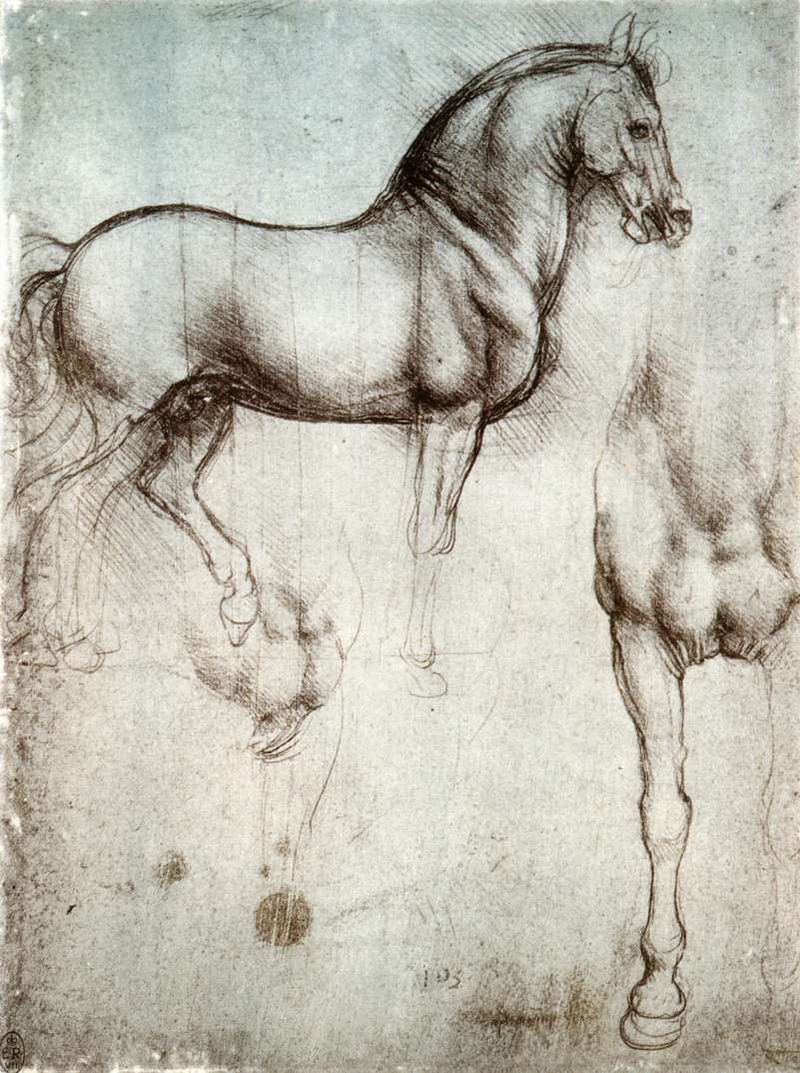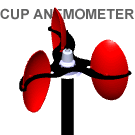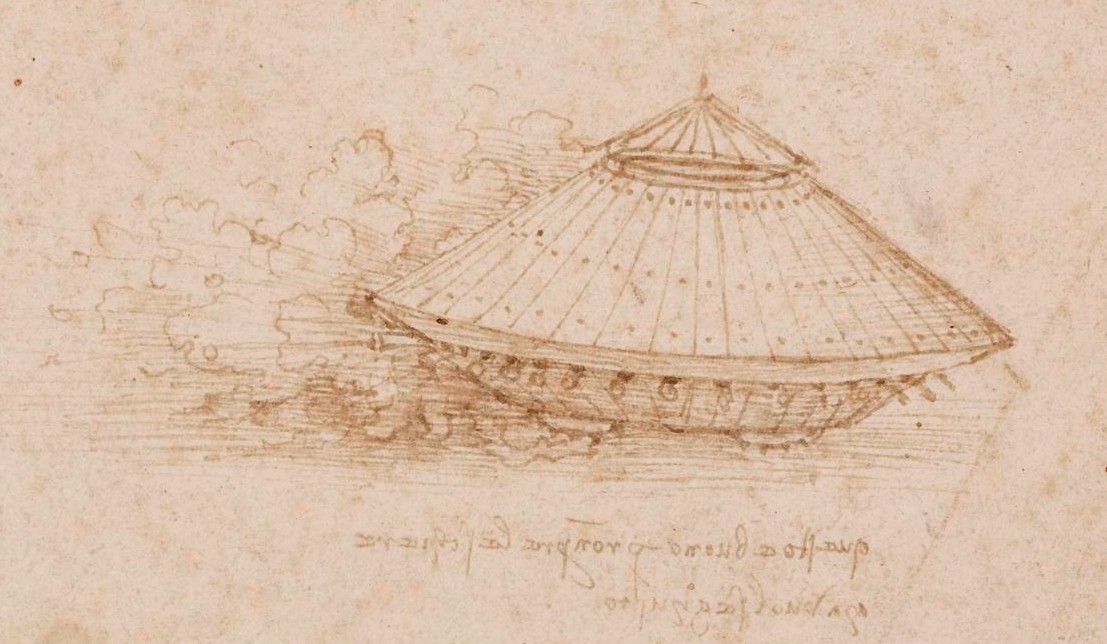Leonardo "made" a bunch of inventions that were "ahead of their time," which is surprising because I always thought that Donotello was the one that
did machines.
Notice the quotation marks around "made," because Leonardo "invented" things in the same way that an eight year old boy "invents" things. He did some drawings on a sheet of paper and claimed it was an invention. No real design of the product and extensive trials. You might as well say that Calvin from
Calvin and Hobbes is "the inventor of the time machine" because he wrote it on the side of a cardboard box. Whatever.
Given that almost all of da Vinci's "inventions" are pretty much bullshit, I'll rank them in order of how cool the actual idea behind the machine is. This has nothing to do with any actual products produced.
15. Colossus / Horse Statue
 |
| The statue would have had a 1/2 ton horse cock. |
- What does it do? It's a statue of a horse. But also large.
- Did it really work? How is a statue supposed to "work?" And
no. Leonardo never actually made it because his plans for it would have
meant it would be 24-feet tall and weigh 80 tons (in bronze). He
couldn't figure out how to make the molds. He couldn't figure out how to
make ovens hot enough for so much bronze. It was commissioned in 1482
by the Duke of Milan, but then war broke out and they wound up using the
bronze for cannons. Which Leo used as a graceful excuse to not admit
that he's a shitty inventor who can't make anything right.
- Who really invented it? People invented statues loooong before recorded history. If we're talking big statues, Rhodes had a giant Colossus which
was a wonder of the ancient world. Eventually some Pennsylvanian pilot
decided to actually make one and donated it to Milan, do does that
count? No.
14. Clock
- What does it do? Tells time. Inventing the clock would be cool. Too bad Leo didn't do that at all.
- Did it really work? As far as I can tell, nobody tested his design to see. And to clarify the above section, in no way did Leonardo da Vinci "invent" the clock. He just invented a
different design that he thought would be more accurate. It would use
springs and measure hours and minutes using different gears. But like I
said, it was never actually physically made.
- Who really invented it? Okay, even discounting ancient devices
used to tell time like sundials, water clocks and hourglasses... it's still fairly difficult to tell when the first "mechanical" clock was invented.
Early sources from the 8th through 14th century AD in both China and Europe
make various mentions of time-keeping devices but don't go into
particulars about how they worked, mechanically. So the "inventor" of the
first truly mechanical clock is lost to history. Christiaan Huygens
(also a famous astronomer), would eventually make great leaps forward in
clock design with the invention of the pendulum clock in 1656, which
would go on to become the most accurate timekeeper for several
centuries.
 |
| Ooh, a gif! |
13. Anemometer
- What does it do? It measures the speed of wind.
- Did it really work? Yeah, sort of. I mean I guess. But then again it was simple and had ALREADY BEEN INVENTED 30 YEARS PRIOR.
- Who really invented it? As I noted, this thing was already invented by the time Leonardo "invented" it. While Leo's version came in the 1480s, the first type of anemometer was described by Leon Battista Alberti in 1450.
12. The "Ideal" City
- What does it do? I don't even know where to begin with this bullshit "invention." Well, it's just a drawing of a city which he
believed to be ideal. Everyone was dying of plague, so Leonardo
designed a city that he thought would avoid stuff massive plague deaths with canals,
broad roads, large arches, pillars, stables for horses, air vents in
buildings, etc.
- Did it really work? Obviously nobody ever built a city based on Leonardo's designs. It just stayed on paper.
- Who really invented it? Will Wright? I don't know.
11. Triple Barrel Canon
- What does it do? Well, this one should be pretty self-explanatory. You know canons? It's like that. But with three barrels.
- Did it really work? Similar to his machine gun idea (see below), I'm not
sure the design was actually ever field tested. It's sort of a
less-ambitious machine gun. Boring.
- Who really invented it? I think it's just him. Normal military commanders would just, you know, wheel out three separate cannons.This is sort of dumb.
10. Parachute
 |
| Yep. This is what I'm going with. |
- What does it do? Jack up the excitement in action movies.
- Did it really work? No. His design was a triangular shape like a tent, rather than rounded. No way would that have enough air resistance to float.
- Who really invented it? Louis-Sébastien Lenormand, a French
chemist and inventor in 1783. It's weird that parachutes were invented
before airplanes, but then again I guess people could have been jumping
off cliffs and stuff. Yeah. It was probably cliffs. Imagine being the poor motherfucker who Lenormand made do the "trial" tests to see if it actually worked.
8. Giant Crossbow
- What does it do? Allow Bron to shoot Drogon, which was a big fucking mistake on his part. Although I guess he lived and he actually hit him... so whatever. Do I actually mean him? I'm not sure. Dragons don't have male/female pronouns.
- Did it really work? As far as I can tell, he only did
drawings and didn't actually design a physical one. Although... I
mean... if someone had actually have made one I'm sure it would have
worked. It's just a BIG crossbow.
- Who really invented it? The "Scorpio" was described by
early-imperial Roman architect and engineer Vitruvius in the first
century BC. The earliest description of the "Ballista" occurs in a
description of weapons made by King Uzziah, who reigned over the Kingdom
of Judah in the eighth century BC. The crossbow itself dates to about
650 BC, coming from China. Basically, tThe idea goes back to antiquity. I'm not sure
that Leonardo should get any points for saying, "yeah... that but
bigger!"
8. Revolving / Swing Bridge
- What does it do? It's a mobile bridge that can be packed up
and moved around for use by armies. It can also swing in other
directions to allow navigation of ships and to block other armies from
crossing.
- Did it really work? It was never actually made. Noticing a common theme?
- Who really invented it? In ancient China, King Wen of Zhou
was the first to create a pontoon bridge in the 11th century BC. The
idea is super old. As for something along the lines of what Leonardo
was probably going for, 19th-Century British civil engineer Isambard
Kingdom Brunel (considered one of the most ingenious and prolific
figures in engineering history) designed a swing bridge in 1849. I actually only know who this guy is because there was a passing reference to him in Doctor Who in the 1980s. Oh, and the Doctor met da Vinci, by the way.
7. Scuba Gear
- What does it do? Allows tourists to enjoy the Great Barrier
Reef until it is completely destroyed by global warming in, I assume,
about four years.
- Did it really work? Obviously not. Leonardo was in Venice and
drew these designs for warfare, imagining that people would deck out in
scuba gear and attack ships from below the water. So really, if
Leonardo invented anything here, then he invented the film Thunderball.
- Who really invented it? This one is tough. The first
practical scuba rebreather with a self-contained breathing apparatus was
designed by diving engineer Henry Fleuss in 1878. If you really want to
notch up the technology you think of when you think of a modern set of
Scuba gear, you have to turn to Frenchmen Émile Gagnan and Jacques-Yves
Cousteau (you've probably heard of the latter), who designed the first
open-circuit-demand scuba gear in 1943.
6. Helicopter / Aerial Screw
 |
| This bullshit will NEVER work. |
- What does it do? Add atmosphere to movies about Vietnam. Also, it flies through a process of lift and thrust via rotors.
- Did it really work? Of course not. Leo was obsessed with wind
and air inventions because he was obsessed with flying. He has a tons
of wind and flying-related inventions. Unlike the modern helicopter,
this was shaped more like a screw (hence "aerial screw," which sounds
either like a more vulgar version of the "mile high club" or what Prince
Eric did to The Little Mermaid after the credits rolled).
- Who really invented it? Let's say that it was
Russian-American aviation pioneer, Igor Sikorsky. Although you could
argue that it was either Henrich Focke or Paul Cornu, based on various
reasons. I'm not going into them. If you're reading this, you're on some sort of computer. Research that yourself.
5. Tank
 |
| I'm just as un-impressed as you. |
What does it do? It's a big, armored vehicle that is
resistant to bullets and all kinds of stuff like that. It also has big
guns/weapons on it so that it can shoot other people. - Did it really work? No, da Vinci’s tank was designed with
powering cranks that went in opposite directions, thus making forward
motion impossible. Some Leo fans claim that this was an OBVIOUS flaw
that he OF COURSE must have known about because he was a genius. So they
make up some elaborate story about how he was a pacifist that designed
this machine to not work on purpose so that it would never be used. Or,
possibly, Leonardo was a dumbass who's inventions were all non-working
bullshit. That's an option too. I'm just putting it out there. Based on the evidence of EVERY SINGLE OTHER THING HE INVENTED, WHICH WAS BULLSHIT THAT WAS IMPRACTICAL.
- Who really invented it? Australian engineer Lancelot de Mole
(what a name!) submitted a proposal for a "chain-rail vehicle which
could be easily steered and carry heavy loads over rough ground and
trenches" to the British War Office in 1912. Although some people credit
Jan Žižka, a Czech national hero who used a similar-ish armed wagon
with guns in battles. But he did that even before da Vinci created his
design.You know what? Fuck Lancelot. My family comes from the Czech Republic, so I'm on Team Žižka here.
4. "33-Barreled Organ" / Machine Gun
- What does it do? Allow mentally unstable people to kill lots
of innocent people really quickly and with almost no background checks.
Uhh... I mean "hunting and personal defense." Yes. That's what I meant
to say. #secondamendment
- Did it really work? I'm not able to find any definite sources
on this thing being tested, but given that machine guns didn't become widely
used in the 15th century, I'm going to go ahead and say, "no."
- Who really invented it? As with many of these examples it was
more of a process than a single invention, but the first gun to offer
controlled, sequential fire with mechanical loading was created by
American (of course, it's a gun) Richard Jordan Gatling in 1861. The Gatling gun saw
limited use in the Civil War. ♪ THE MORE YOU KNOW. ♪
3. Car
- What does it do? I assume I don't have to explain a "car" to you.
- Did it really work? Not in his lifetime because, as usual, it
was never actually made. Supposedly in 2006, some Italians made a
working "self-propelled cart" based on his designs and lauded him as a
genius. But then again the term "based on his designs" is a little
questionable. You know how movies are "based on a true story" and are wildly different from what actually happened? I'm sure the Italians filled some major holes in Leo's
designs to make sure it worked as a sense of national pride.
- Who really invented it? German engineer Karl Benz in 1885. You may remember him better from his time in an 80's pop group with his colleague, Mercédès. 1880's, I mean.
2. Flying Machine
 |
| This shit drawing is what people call "an invention." |
- What does it do? It's an airplane, dumbass. Or, I guess more accurately an "ornithopter," which means a plane that flaps wings. Do you need the concept of an airplane explained to you? Are you John Madden?
- Did it really work? Absolutely not. He made some sketches that were based on winged animals like bats and birds. Really, it mostly looked like a bat. So da Vinci really invented the Batwing.
- Who really invented it? The Wright Brothers, in 1903. Well, that's the most official and well-known story. Really inventions are more of a "process" than a single event, and you can point to lots of antecedents (including da Vinci) in the invention of the airplane. Why is this ranked so much higher than helicopter? Because planes are awesome and helicopters are death traps.
1. Robot
- What does it do? Leonardo designed a knight-in-armor which used mechanical parts like pulleys, weights and gears.
- Did it really work? Hell no. Just because this is ranked #1, don't think that da Vinci got around off his lazy ass to actually MAKE one. Do you think ROBOTS were around in the 1400's? That's crazy talk. In fact, Leonardo's full designs for this (if you can call any of this designs "full") don't even still exist, and only scattered fragments referencing it can be found in his notebooks.
- Who really invented it? A difficult question to answer, but let's go with American inventor George Devol, who in 1954 created the first digitally-operated and a programmable robot called the "Unimate." The Japanese took the "mate" part of "Unimate" a little too seriously and have been trying to create screw-able robots ever since.





No comments:
Post a Comment